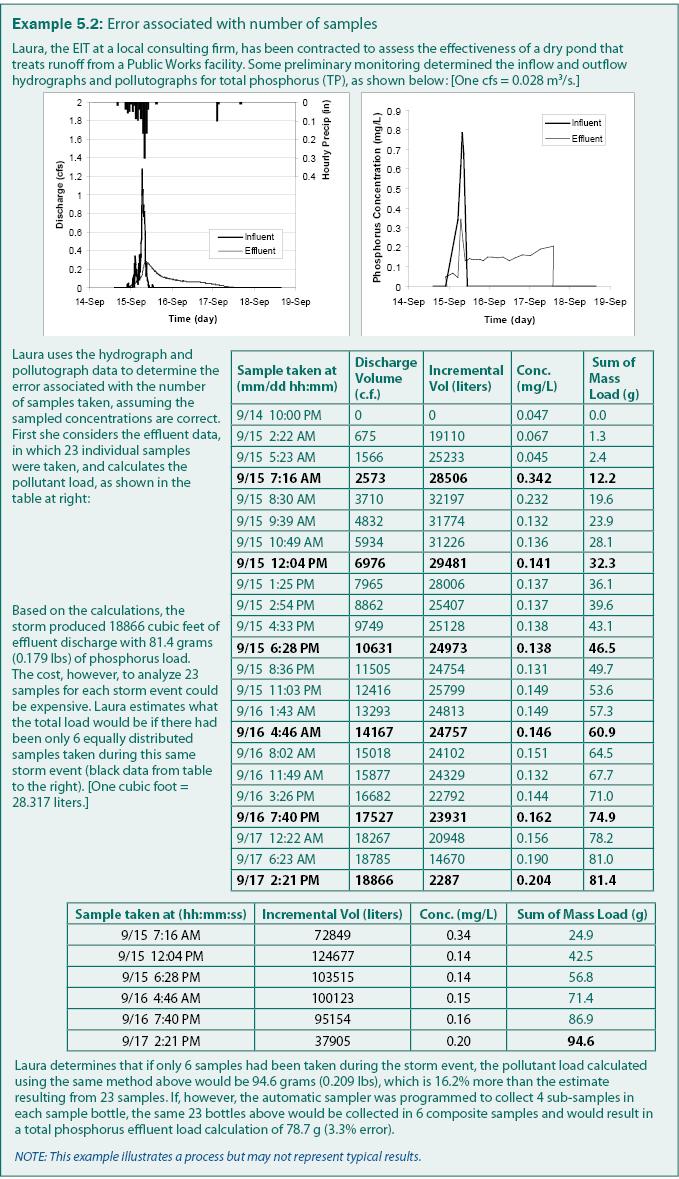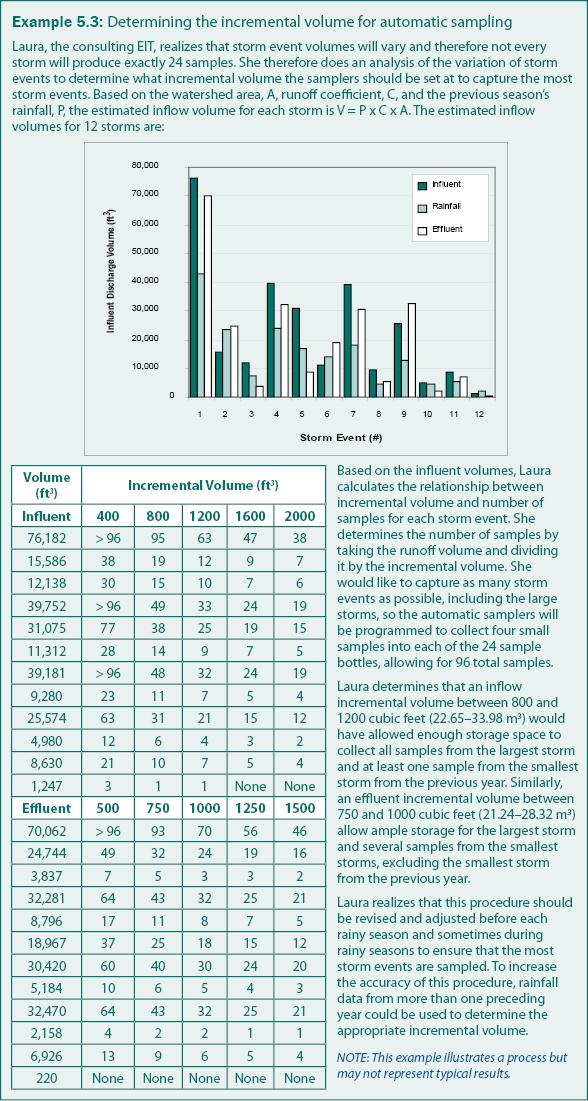
Samples per storm events
P.T. Weiss, A.J. Erickson, J.S. Gulliver, R.M. Hozalski, O. Mohseni, and W.R. Herb
The U.S. EPA (U.S. EPA 2002) recommends that multiple samples be taken throughout a storm event to incorporate changes in concentration and discharge and therefore accurately represent the storm event. Choosing an appropriate number of samples per storm event will depend upon the basis on which the samples will be taken: discharge, time, or grab samples.
Flow-weighted, time-weighted, and user-defined sampling
The frequency with which samples are typically collected can be defined by three approaches: (1) flow-weighted, (2) time-weighted, and (3) user-defined. Any of these sampling approaches can be used to collect in situ, on-site, grab, or automatic samples. There are also two methods of sample storage: discrete and composite. Sample storage is not required for in situ samples and most in situ samples are time-weighted. Samples are typically described by the method of collection and storage (e.g., flow-weighted discrete samples) but could be in situ, on-site, grab, automatic, or some combination thereof. The most common sampling programs are time-weighted in situ, flow-weighted discrete (automatic), flow-weighted composite (automatic), user-defined discrete (on-site), and user-defined discrete (grab). In all cases, influent and effluent discharge must be measured and recorded so that pollutant removal efficiency can be determined.
Flow-weighted sampling
Flow-weighted sampling involves collection of samples after a constant incremental volume of discharge (e.g., 5000 gallons) passes the sampler. Each flow-weighted sample is assumed to represent the average pollutant concentration for the entire incremental volume of water to which it corresponds. If the pollutant concentration changes quickly, drastically, or both, the measured pollutant concentration may not represent the average pollutant concentration accurately for the incremental volume. Small incremental volumes may require the collection of more samples than the automatic sampler can hold (typically 4 to 24 bottles, or 4 to 96 samples) or faster than grab samples can be collected, which could result in sampling only part of a storm event. The advantage of flow-weighted samples is that summation of loads and EMC calculations are simplified and presumed to be more accurate because the discharge volume is constant for each representative sample. The most common flow-weighted samples are automatically collected discrete or composite samples. The relationship between sampling accuracy and the number of samples taken is shown in example 5.2.

The number of samples collected depends on the influent discharge of each storm event and the incremental volume. Selecting the optimum volume increment depends on the size of the watershed, land cover, soil type, slopes, and expected rainfall intensity and discharge volume of the storm events. Due to the unpredictability of rainfall, the selection of a flow increment will always involve some uncertainty. An approach for selecting the incremental sampling volume is provided in example 5.3.

Time-weighted sampling
Time-weighted samples are collected at a user-specified, constant time interval (e.g., 30 minutes). Because the discharge of natural storm events is not constant, time-weighted samples do not represent constant volumes of flow with respect to time. Total discharge volume for each time interval must be calculated before calculation of summation of loads or event mean concentration. The time-weighted approach is common for in situ, on-site, and grab sampling.
The calculations for time-weighted samples can be more complicated than those for flow-weighted samples because each sample must be weighted by the corresponding discharge volume. In these cases, discharge volume for each time interval must be calculated by integrating the discharge versus time curve.
Selection of the optimal time increment will depend on the duration of a ‘typical’ storm event and the variation in storm event duration. It is also important to consider the amount of time required to collect in situ, on-site, and grab samples or the maximum number of samples the automatic sampler can collect, if applicable. Due to the unpredictability of rainfall events, however, the selection of a time increment will always involve some uncertainty.
User-defined sampling
User-defined samples are collected on a basis determined by the user and is commonly chosen based on the hydrology of the system being assessed. For example, some sampling programs may collect a specified number of grab samples during the rising and falling limbs of a storm event. The discharge and time increment between these samples will vary between samples and for each storm event. Similar to time-weighted sampling, total discharge volume for each interval between samples must be calculated before calculation of summation of loads or event mean concentration. User-defined sampling is most common for manually collected samples (i.e., on-site or grab samples).
Discrete and composite samples
Once it is determined how samples will be collected (flow-weighted, time-weighted, or user-defined), the next step is to determine whether to collect discrete (i.e., separate) samples or a composite sample(s). Discrete samples are collected in individual containers and the contents of each container are analyzed separately. Composite samples are collected in a single container and analyzed as a single sample representative of the entire sampling period.
Discrete samples can be collected manually for on-site or grab sample analysis, or with automatic samplers equipped with multiple sample containers. Most often, discrete sampling is only necessary when a record of temporal variation in pollutant concentration throughout a storm event (e.g., minimum, maximum, etc.) is desired. The main disadvantage of discrete sampling is that multiple samples must be analyzed for pollutant concentration for each storm event, which can increase the costs of an assessment program significantly.
Composite sampling combines all collected samples into one large storage container and should only be used in conjunction with flow-weighted sampling. Time-weighted composite samples cannot be used to determine pollutant loads or EMC because each time-weighted subsample does not represent equivalent volumes of discharge. Thus, if time-weighted sampling is used, samples should not be stored as composite samples.
Discrete and composite sampling can be used with on-site, grab, or automatic samples but most automatic sampling equipment is designed specifically for one method or the other. Thus, in order to ensure compatibility between an assessment program and sampling equipment, it is recommended that the goals and details of the assessment program be developed before purchasing sampling equipment (see Developing as Assessment Program).
It is important to note that flow-weighted samples can be collected either as discrete or composite samples because the volume increment is the same for each sample. Each sample added to a composite sample represents the same volume increment of stormwater and is therefore equally representative. Therefore, chemical analysis is considerably cheaper for flow-weighted composite samples compared to flow-weighted discrete samples.
Time-weighted samples, however, can only be collected as discrete samples because each sample represents a different volume of stormwater. It may be important to consider the parameters used by stormwater models (e.g., XP SWMM, WinSLAMM, etc.) when developing a sampling program because some models input sampling parameters (such as discrete samples) directly. Unless the goal is to measure pollutant removal performance as it changes throughout the storm, flow-weighted, composite sampling is recommended because of the cost savings of analyzing only one sample per storm event.
Continue to In situ, on-site, and grab, and automatic sampling.